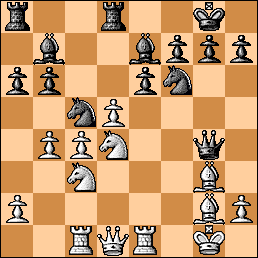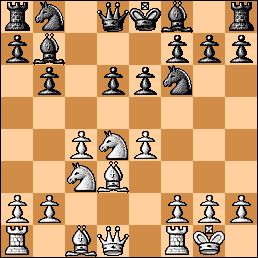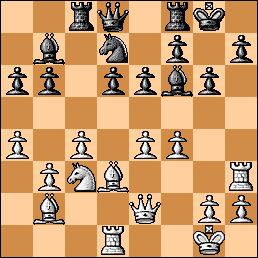The Hedgehog is a prickly animal. Let’s see a couple of aggressive anti-Hedgehog systems which I’ve tried vs NMs, IMs, and GMs alike.
IM Mark Ginsburg vs NM Teddy Coleman
2006 World Open, Philadelphia, PA
1. c4 c5 2. Nf3 Nf6 3. Nc3 e6 4. g3 b6 5. Bg2 Bb7 6. O-O Be7 7. Re1 d6 This is the mainline Hedgehog where White has fianchettoed his king bishop. See the next game for a different idea, the placement of the Bishop on d3 (only possible in certain move orders). 7…d5 is a solid move here and worthy of serious attention. It is good to learn those positions as a nice change of pace because black gets a much bigger piece of the center than usual.
8. e4 a6 9. d4 cxd4 10. Nxd4 Qc7 11. Be3 O-O 12. Rc1 Nbd7 13. f4 The only way to try to punish black is by grabbing this space. Needless to say, white should not spend time guarding the c-pawn which is immune for the moment.
13… Rfd8?! Unnatural. 13…Rfe8!? is a better rook move; white should then react similarly with 14. g4. However, the strongest according to current thinking is 13…h5!? It’s very strange to move a pawn in front of one’s king, but black argues that it’s more important to hold up the g4 advance. After 13…h5!? 14. h3 Rfe8 15.f5 Bd8!? black holds on. White can play more sharply with 13…h5!? 14. f5!? but black again retains decent chances with 14…Ng4! – as of this writing, 13…h5!? has not been refuted.
14. g4!? Black’s minor pieces are in a tangle and white wants to push them around. Strangely, the move 14. f5! may be stronger here. White gets a clear plus after 14…e5 15. Nd5.
14…Nc5 15. Bf2 d5? This move, always a possibility in Hedgehogs, doesn’t work here for tactical reasons. 15…Nfd7 was necessary; 16. b4 Nf8!? awaiting events.
16. exd5 Qxf4 17. Bg3? 17. b4 is a clean win. 17…Qxg4 18. bxc5 Bxc5 19. Na4! finishes it.
17…Qxg4 18. b4
18… Qxd1? The last chance was 18…Qg6 19. bxc5 Bxc5 but after 20. Na4!, white should win.
19. Rcxd1 Ncd7 20. d6! Very obvious but an important tactical motif to remember.
20…Bxd6 21. Bxb7 Bxb4 22. Nc6 Bxc3 23. Re3 Ba5 24. Nxd8?! 24. Red3! is the correct move, winning quickly.
24…Rxd8 25. Red3 b5 26. cxb5! There was a chance to go wrong here: 26. c5?? Nd5! and black escapes.
26…axb5 27. Bc6 A fatal pin. Black wriggles a little more but it’s over.
27… Bb6+ 28. Bf2 Bxf2+ 29. Kxf2 Ng4+ 30. Kg3 Nge5 31. Rxd7 Nxd7 32. Bxb5
1-0
Here’s a similar story with a similar happy ending from Switzerland (Lenk) 2000.
IM Ginsburg – NM F. Epiney Lenk 2000
1. c4 Nf6 2. Nc3 c5 3. Nf3 e6 4. g3 b6 5. Bg2 Bb7 6. O-O a6 7. Re1 d6 8. e4 Be7 9. d4 cxd4 10. Nxd4 Qc7 11. Be3 Nbd7 12. Rc1 O-O 13. f4 Rac8 Diverging from the Coleman game above.
14. g4 The immediate 14. f5 e5 15. Nd5 Qd8 is not particularly effective. White has to try the text to get somewhere.
14…Rfd8? This is weak. But 14…Nc5 does not help matters after 15. Bf2. For example, 14..Nc5 15. Bf2 h5 16. gxh5 Kh7 17. b4 Ncd7 18. e5 dxe5 19. fxe5 Ng8 20. h6 Nxh6 21. Ndb5 axb5 22. Nxb5 Qb8 23. Qxd7 Bxg2 24. Qxe7 Bc6 25. Nd6 Nf5 26. Nxf5 exf5 27. Qh4+ Kg8 28. Rc3 and wins. Another logical try, 14…g6, is met by 15. g5 Nh5 (15…Ne8 is passive, for example 16. Bh3 Ng7 17. f5! with a large edge) 16. f5 Ne5 17. b3 Qd7 18. Bh3! and white has a big plus.
15. g5! Ne8 16. f5! Of course. Once black gives up the key light squares, it’s all over.
16…exf5 17. Nd5 Bxd5 18. cxd5 Qb7 19. Nc6 Ne5 20. exf5 Rd7 21. Bf4 f6 22. Bxe5 fxe5 23. f6! Total paralysis.
23…gxf6 24. Qg4 f5 25. Qxf5 Ng7 26. Nxe7+ Rxe7 27. Rxc8+ 1-0
A very smooth and effortless victory.
Things are not always so easy. IM Roussel-Roozman tried the same approach vs IM (GM-elect) Jesse Kraai and lost. (in the …h5 line).
Here’s a wild affair where I battled veteran GM Leonid Yudasin in a related line.
However, in this line I put my KB on d3 and I don’t fianchetto it – an extra opportunity white gets in the move order Yudasin adopted.
IM Mark Ginsburg – GM Leonid Yudasin World Open 2003
1. c4 c5 2. Nf3 Nf6 3. Nc3 b6 4. e4! d6 5. d4 cxd4 6. Nxd4 Bb7 7. Bd3! This is the more aggressive formation white can get, exploiting black’s slow first moves.
7…Nbd7 8. O-O e6 9. Qe2 Be7 10. b3 O-O 11. Bb2 a6
11..Ne5!? 12. Bc2 Ng6!? is an interesting possibility to ‘change the usual course of events’.
12. f4 Re8 13. Rad1 Qc7 14. Kh1 Bf8 15. Nf3! White is getting his pieces to very dangerous squares; every piece is working which is nice when one has attacking ambitions.
15…g6 This position has been seen before. I didn’t know that; if I did, I might have known the right move!
This is the key moment.
16. Bb1? No!!! The right move is 16. e5! Nh5 17. Be4! ignoring the knight attack on f4. White is better in all lines. This was proven in Ambroz-Summermatter, Bad Ragaz 1997. Black played 17…d5 18. exd5 Nxf4 19. Qd2 and white was better and went on to win. Note that 16. e5 dxe5? 17. fxe5 Nh5 18. Be4! is even worse; and after 17. Be4! Nxf4?? is a gross blunder due to 18. exd6! winning in all lines (18…Bxd6?? 19. Qd2 wins right away). It is very important to remember this positionally very strong maneuver (e5 clearance then Be4).
16…Rad8! Black consolidates, defusing e4-e5. White lost his chance.
17. Ng5 Bg7 18. e5 dxe5 19. fxe5 Nxe5 20. Rxd8 20. Nb5!? right away is interesting.
20…Rxd8 21. Nb5 axb5 22. Bxe5 Qe7 23. cxb5 h6 24. Nf3 Qc5 Black is fine now, and white has less time. Not a pleasant situation.
25. Qc4? Not good. However, there were no easy ways to play.
25…Qxc4 26. bxc4 Rc8 27. Bd3 Nd7 28. Bd6 Nc5 29. Bxc5 Rxc5 30. Nd2 Rc8 31. Nb3 Rd8 32. Rd1 Bf8 Black has a really nice and solid ending advantage now. White does not offer very serious resistance.
33. Be2 Ra8 34. Rd2 Bb4! 35. Rb2 Be4! Accurate.
36. Bf3 Rd8 37. Kg1 Bd3 38. c5 bxc5 39. b6 Bc3 40. Rf2 c4! White has no hope left.
41. Nc5 Bd4 42. Nxd3 Bxb6 43. Kf1 Bxf2 44. Nxf2 c3 45. Be4 Rd2 46. Ke1 f5 47. Bd3 Rxa2 48. Bc4 Rxf2 0-1
A good technical ending by Yudasin but disappointing for me because I bungled a promising attacking position.
Let’s see a third game, from a Swiss in Switzerland (!), where this setup did better.
Mark Ginsburg vs Thomas Saladin
Lenk Open 2000, Lenk Switzerland
Lenk is a very pretty postcard-type town high in the Swiss Alps. The 2000 event saw Tukmakov, Gheorghiu, Grozpeter, and a host of other strong players competing for not so much cash, but it definitely was a good time. I was working in Basel at the time.
1. c4 c5 2. Nf3 Nf6 3. Nc3 b6 4. e4 d6 5. d4 cxd4 6. Nxd4 Bb7 7. Bd3! I get my preferred set-up.
7…e6 8. O-O
8… Nc6?! 8…Nbd7, as in the Yudasin game, is to be preferred. White now gains time to further his plans.
9. Nxc6! Bxc6 10. b3 a6 11. Bb2 Be7 12. Qe2 Bb7 13. f4! O-O
14. Rf3 g6 15. Rh3 Nd7 16. a4! White keeps black bottled up.
16…Bf6 17. Rd1 Rc8 By simple means, white has acquired a large advantage – space and initiative.
18. Bc2 Qc7 19. Rhd3 Black cannot meet well this regrouping.
19…Be7 20. e5! d5 Desperation already; this move is refuted.
21. cxd5 exd5 22. Rxd5 Bxd5 23. Nxd5 Bc5+ 24. Kh1 Qc6 25. Be4 Qe6 26. b4 Bxb4 27. Nxb4 Qc4 28. Bd3 Qxb4 29. e6! A nice breakthrough.
29…Nc5 30. e7! Excelsior!
30…Rfe8 31. Qe5 f6
32. Qxf6! This quickly forces mate.
32…Rxe7 33. Qh8+ Kf7 34. Qg7+ Ke8 35. Bxg6+ 1-0
Isn’t it funny how a good setup versus a GM sometimes doesn’t do as well as the same setup versus a lesser light? Well, sometimes it works. Here’s a quick win over D. Gurevich in the Milwaukee, WI G/30 champs, 2002.
IM Ginsburg – GM D. Gurevich G/30 Milwaukee WI 12/02
1. c4 c5 2. Nf3 b6 3. Nc3 Bb7 4. e4 d6 5. d4 cxd4 6. Nxd4 Nf6
7. Bd3! e6 8. O-O Nbd7 9. Qe2 a6 10. b3 Be7 11. Bb2 O-O
12. Rad1 Re8 13. f4 Bf8? Careless. In this G/30 encounter, black simply forgets his N is embarrassed after white’s next.
14. e5 dxe5 15. fxe5 Bc5 16. Na4! The motif we know from the Coleman game, above. Black’s game is hopeless.
16…Nxe5 17. Qxe5 Bd6 18. Qe2 Qc7 19. Rxf6! In G/30, it’s better to force matters and keep the initiative to make sure no surprises happen.
19…Bxh2+ 20. Kh1 Qg3 21. Rxf7! It’s always pleasant to continue to take things with an en prise piece.
21…Kxf7 22. Qh5+ Ke7 23. Qxh2 Qxh2+ 24. Kxh2 1-0
Summary: if white plays aggressively versus the Hedgehog, there are good chances to cause concrete defensive problems early on – a good thing!












